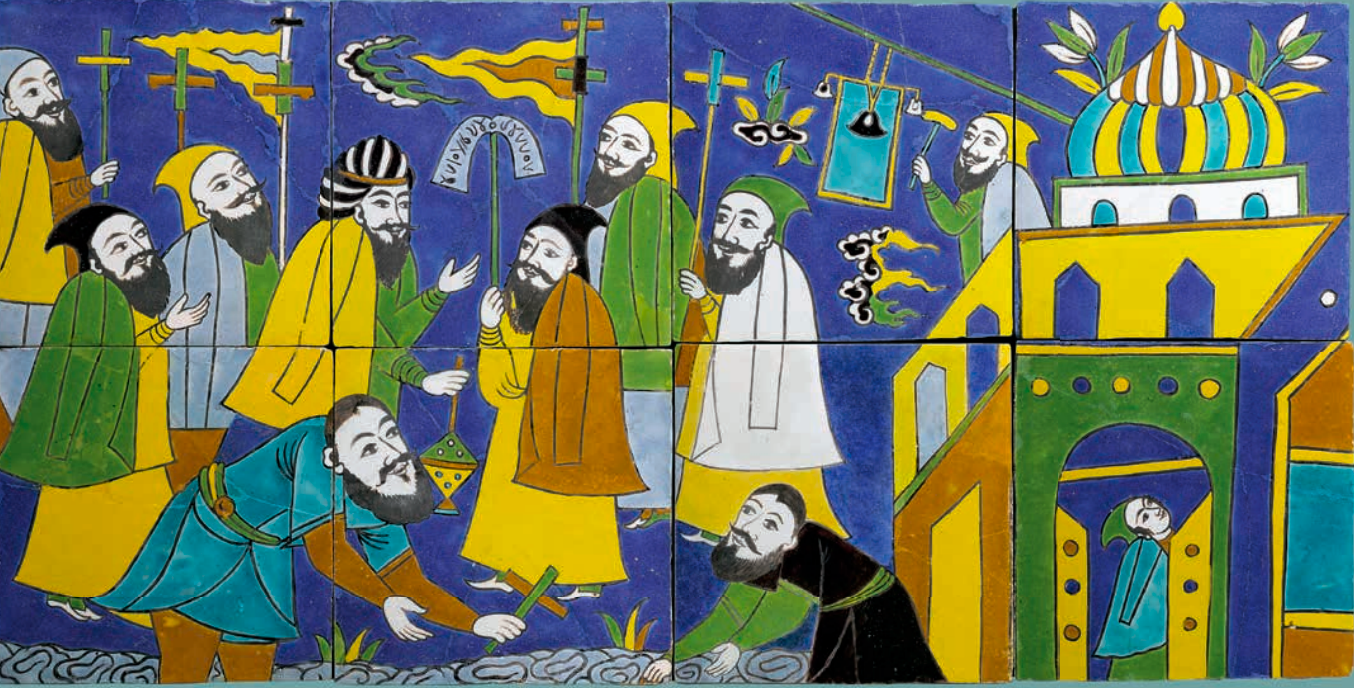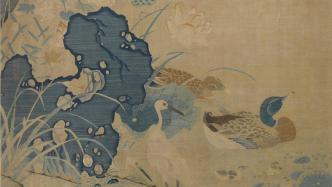

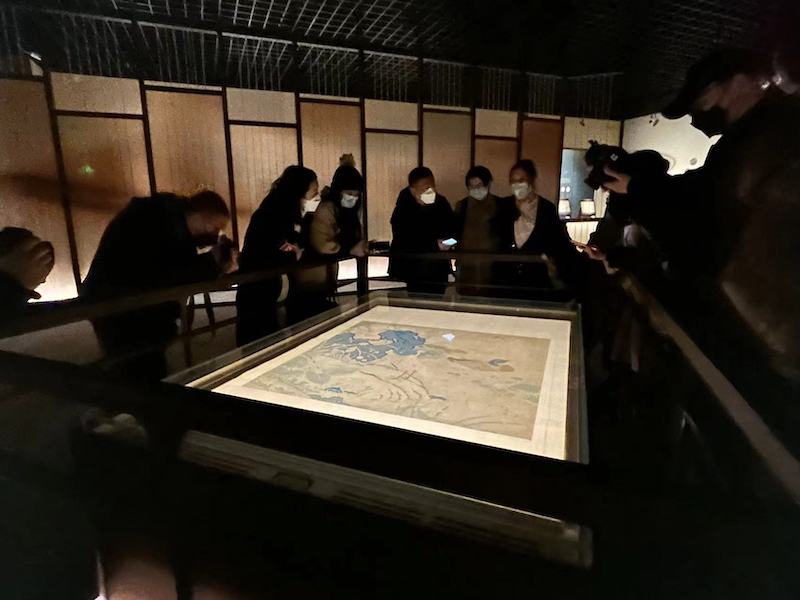
exhibition site
Kesi "Duckling Duck in Liantang" is woven with colored silk thread in its entirety. The Paper reporter saw at the scene that in the work, two mallard-headed ducks float among the weeds, with suckling ducks on their tails, a pair of egrets beside them, and kingfishers, red dragonflies and water striders dotted among them... "According to the whole picture For the topic selection, it can be speculated that all animals and plants should be in pairs, which symbolizes the auspicious meaning of harmony between husband and wife, and more children and more blessings." said Yu Ying, a researcher at the Arts and Crafts Department of Shanghai Museum.

Zhu Kerou's Kesi "Duckling Duck in the Lotus Pond" (partial)
Except for the leisurely and contented birds and insects in the lotus pond. The bluestone on the slope bank has a dignified texture, surrounded by white lotus (white lotus), arrowroot, lotus (red lotus), daylilies and other flowers and plants, with elegant colors, precise lines and full of interest.
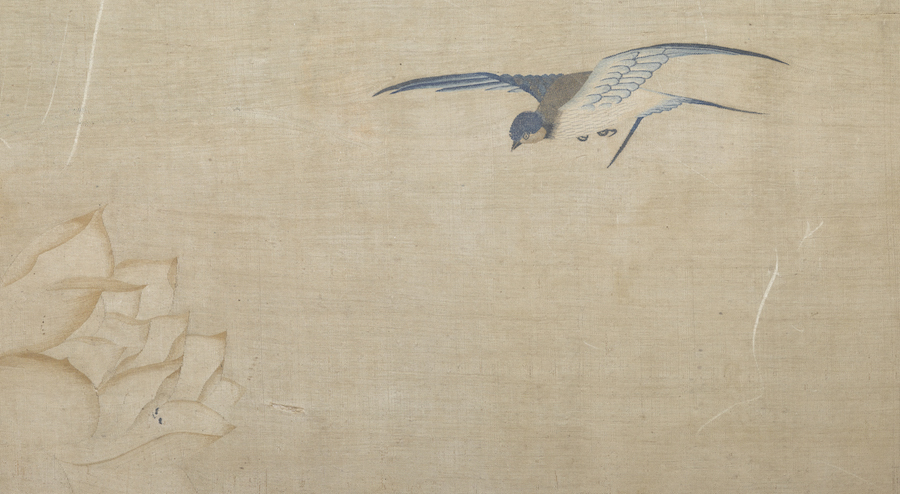
Zhu Kerou's Kesi "Duckling Duck in the Lotus Pond" (partial)
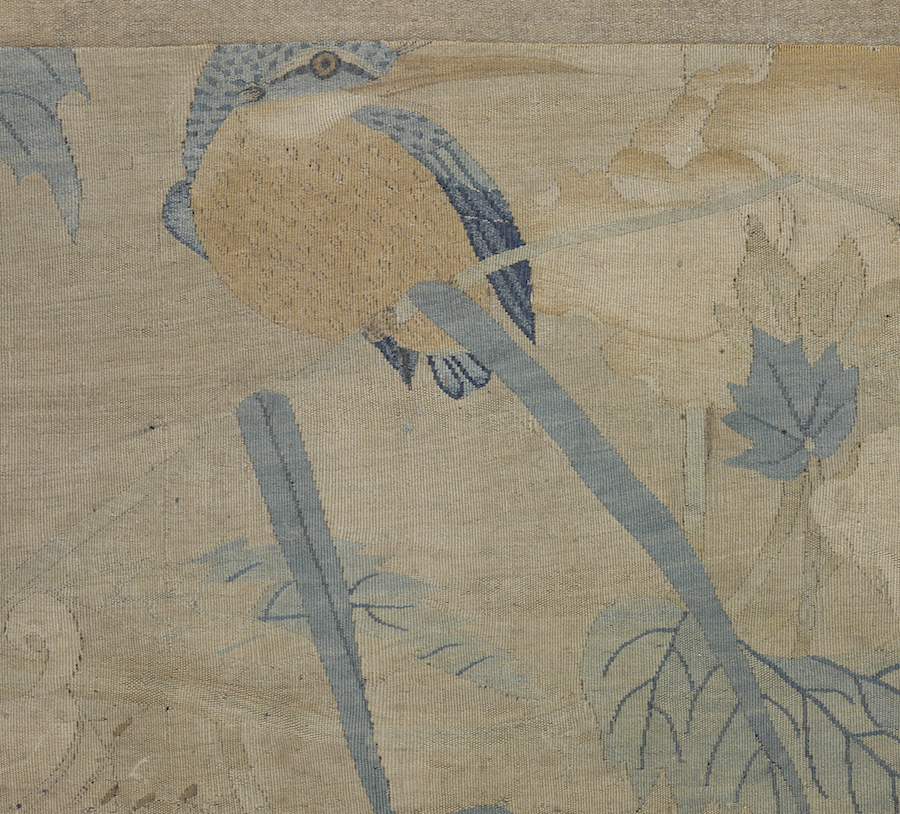
Zhu Kerou's Kesi "Duckling Duck in the Lotus Pond" (partial)
"The Picture of Duck in Liantang" is the only huge handed down treasure by Zhu Kerou in the Southern Song Dynasty. It was collected by Pang Yuanji and donated to Shanghai Bo by the Pang family. Since it was collected in the Shanghai Museum in 1952, it has been exhibited briefly; but due to the fragility of silk fabrics and the need for cultural relic protection, it has not been shown for decades. This exhibition is the first time that "Duckling in the Lotus Pond" meets the audience at the People's Square venue of the Shanghai Museum. This time, together with "The Picture of Duck in the Lotus Pond", there are two Kesi works from the Ming and Qing Dynasties donated by the Pang family.

Qing Kesi Flower and Bird Painting

Qing Kesi bergamot flower and bird painting
Kesi is a weaving technique that passes through the warp and weft. It was introduced to the Central Plains along the ancient Silk Road, so it has the name "Kesi". Because of the time-consuming and labor-intensive weaving, it can be called "an inch of gold". Influenced by the court painting highly praised by Emperor Huizong of Song Dynasty, Kesi techniques changed from flat Kesi and Gou Kesi techniques mainly used for patterns and patterns in Tang Dynasty to a variety of Kesi techniques that blended with the interest and artistic conception of painting, forming different schools. Zhu Kerou of Southern Song Dynasty is one of its representatives. Zhu Kerou combined the art of courtyard painting with Kesi technique, using slender mixed-color flower thread (co-flower thread) for color matching, and Kesi technique to imitate the brushwork of ink and wash. The color halo effect is natural and exquisite. It is "Zhu Ke".
According to Yu Ying, the unrecognizable painting effect made by Kesi weaving technology is even more meaningful than painting. , the charm is agile, making people truly feel the charm of silk and the spirit of painting."
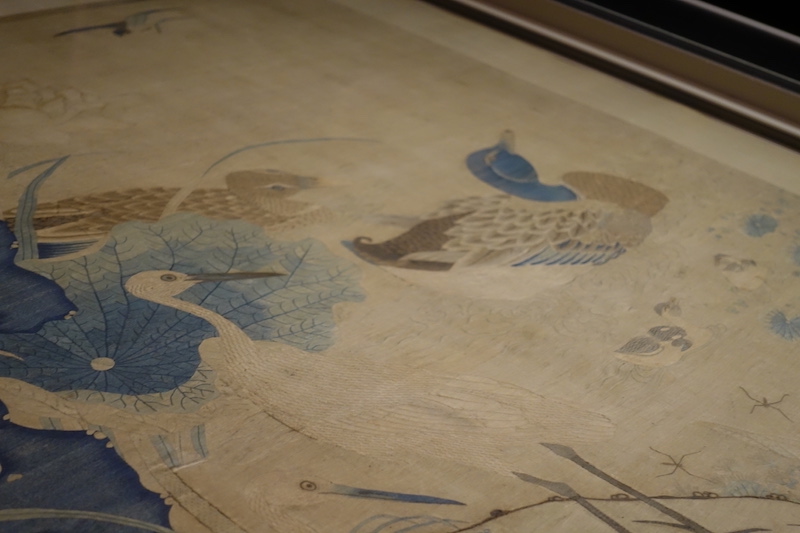
Zhu Kerou's Kesi "Duckling Duck in the Lotus Pond" (partial)
The duration of this exhibition is very short, only 16 days. Silk cultural relics are fragile and have extremely high requirements on the exhibition environment, temperature and humidity. For the exhibition of "Liantang Duckling Picture", Shanghai Bo also displayed its special showcase. Due to the protection requirements of cultural relics, the exhibition will adopt the method of time-limited, limited-flow, and appointment-based visits.
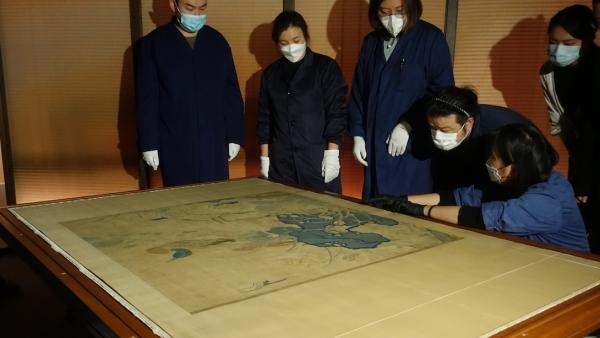
The Paper: Last year, the Shanghai Museum held the "Silk Painting——Ming and Qing Kexiu Painting and Calligraphy Exhibition". One year later, Shanghai Bo once again exhibited an exhibition on the theme of Kesi. What is the significance of this exhibition?
Yu Ying: The last exhibition was about Kexiu calligraphy and painting in Ming and Qing Dynasties, not only Kesi works but also embroidery works. A category of art. Many viewers are actually not familiar with this category, and even can’t tell the difference between Kesi and embroidery, so we put them in an exhibition hall for comparison and echo, and made some 3D animations to let everyone know that Kesi has faded out of daily life. Excellent silk embroidery and silk weaving crafts.
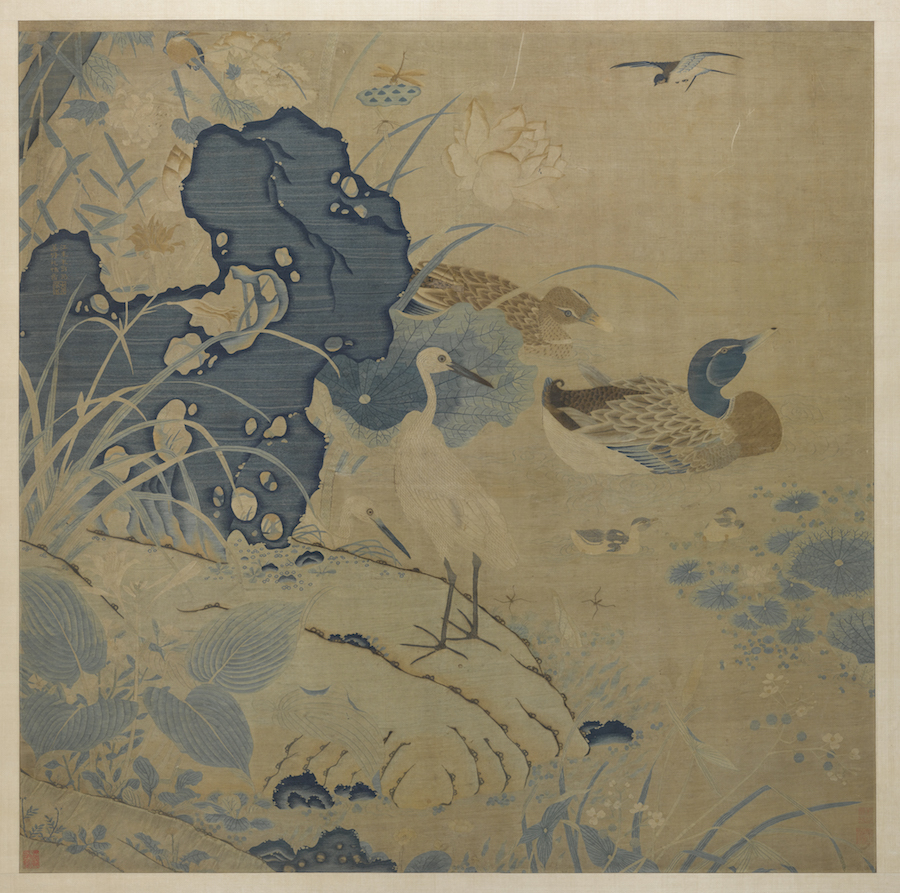
Zhu Kerou Kesi "Duckling Duck in the Lotus Pond"
And this time, on the occasion of the 70th anniversary of the establishment of the Shanghai Expo, at this meaningful point of time, the national treasure Zhu Kerou Kesi "The Picture of Suckling Duck in the Lotus Pond" is presented for everyone to appreciate. Previously, the National Treasure Program made a story interpretation of "The Picture of Suckling Duck in the Lotus Pond", which attracted widespread attention and made people all over the world marvel at the unrecognizable painting effect made by this weaving technology. This effect is even more intriguing than painting, because it has a slight luster, while painting does not have the change of silk luster. The color of Kesi works will change with the change of appreciation angle and the change of light intensity, so as to be closer to the texture of the real ecological environment seen by people's naked eyes. This is also from the perspective of appreciation, Kesi and painting The biggest difference.
The previous exhibition was an art popularization based on the Ming and Qing Dynasties. In the Ming and Qing Dynasties, Song Kesi was the benchmark, and Song Kesi was modeled on the two masters of the Southern Song Dynasty, Zhu Kerou and Shen Zifan. As "The Picture of Suckling Duck in Liantang Pond" has been listed as a national treasure, there have been calls for this work to be exhibited in the past three years. So this time it is to present the top national treasures and show what the pinnacle of silk weaving art looks like.
The Paper: Can you introduce this exhibition and the development history of Kesi presented in the exhibition?
Yu Ying: The beginning of this exhibition presents the ins and outs of Kesi techniques. On the ancient Silk Road, a kind of Kesi weaving craft of "passing through the meridian and returning to the weft" was spread along the way. From the end of Tang Dynasty to the beginning of Song Dynasty, Uighurs who were good at weaving began to make Kesi, and then it was introduced to the Central Plains. Its structure is actually very simple, but weaving is time-consuming and labor-intensive, which is why Kesi is called "inch Kesi gold".
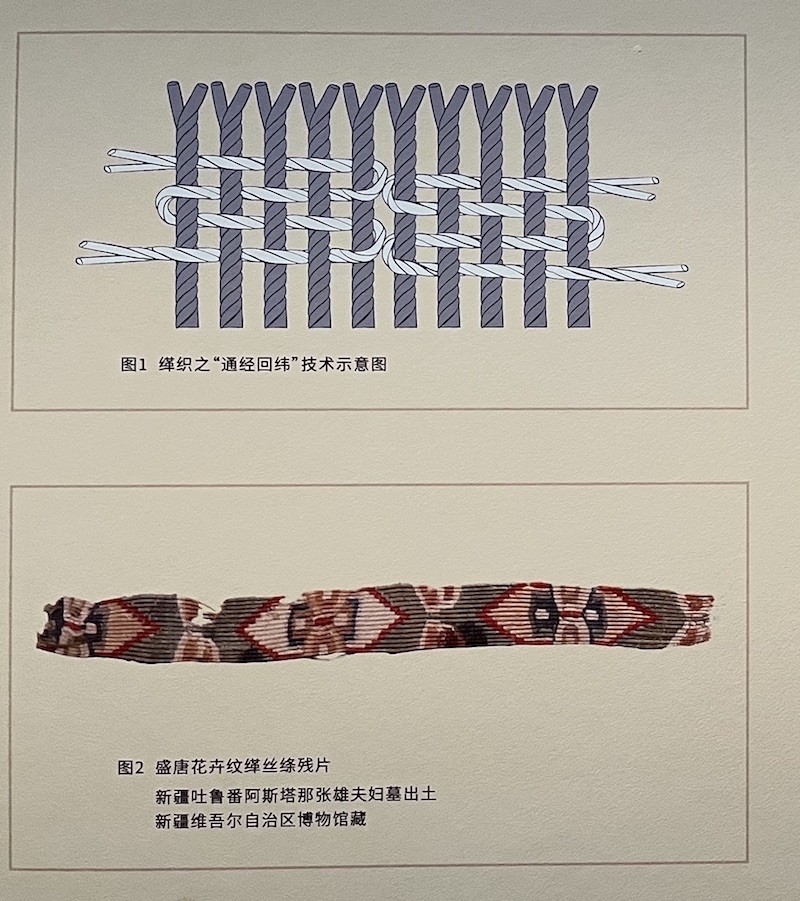
Exhibition site, (above) technical schematic diagram of "passing the warp and returning the weft", (below) fragments of silk tapestry with floral patterns in the Tang Dynasty
The earliest unearthed cultural relics about Kesi are the Kesi belts on the costumes of female figurines of the Tang Dynasty, which are very small and only about 1 cm wide. The wider tapestry unearthed later is the decorative strip on the clothes, which comes from the clothing of the Hu people. In the Northern Song Dynasty, the official "Kesi Zuo" was established to be responsible for weaving Kesi, which was used as the wrapper for the binding of fine calligraphy and painting. At the beginning, Jirui flower and bird patterns were mostly seen, and the patterns were composed like brocade, commonly known as "Jinqi". The Baotou made of Kesi is specially used for high-end calligraphy and paintings of the Jin and Tang Dynasties. For example, the Baotou of "Nv Shi Zhen Tu" is a Kesi painting with a peony pattern. As a result, Kesi gradually became associated with painting, and painting also exerted a subtle influence on the development of Kesi.
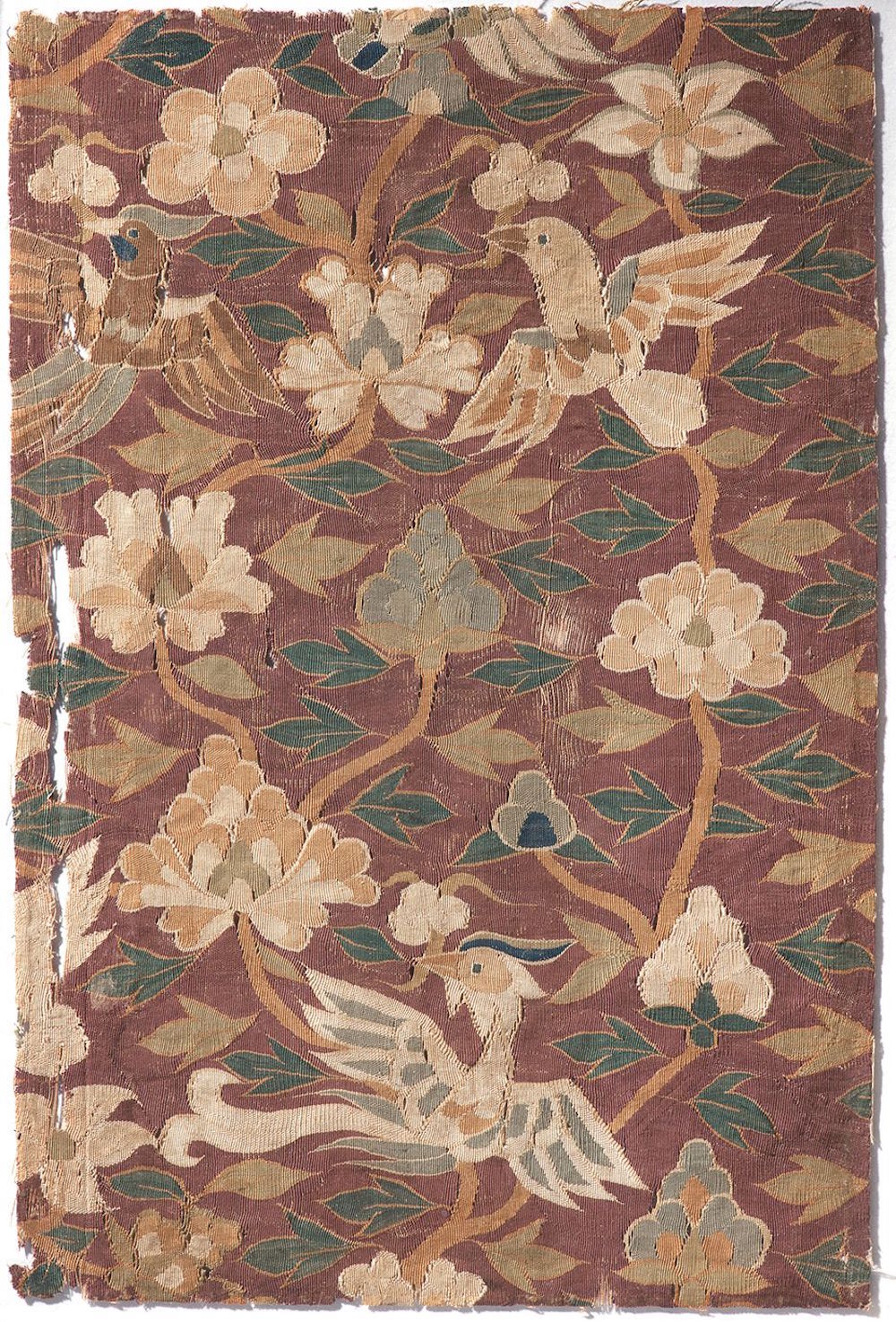
Northern Song Kesi Purple Luan Magpie Bundle, Collection of Shanghai Museum
During the Northern Song Dynasty, the drawings of Emperor Huizong also began to be woven into Kesi. On the exhibition board, we can see that Song Huizong's paintings are also made of Kesi, which is very fine. At the same time, it can also be seen from the exhibition boards that the original Kesi works tended to be patterned, relatively old-fashioned, and the color combination was not smooth enough. In the Southern Song Dynasty, as an independent art, Kesi calligraphy and painting had been getting better day by day, and gradually there were famous artists, who left signatures on their works.
Famous artists at that time included Zhu Kerou and Shen Zifan, both of whom had distinct styles of Kesi painting, each with its own merits. Shen Zifan's Kesi paintings are majestic, vigorous and powerful, and can be used for both flowers, birds, landscapes, and they are not limited to details, but they are large-scale. Zhu Kerou is good at flowers and birds, and all the flowers and birds, lakes, rocks and slopes in the keto are real, delicate and lifelike. Under the change of silk light, the artistic conception of the picture is more meaningful and elegant, with vivid charm, which makes people truly feel the charm of silk and the spirit of painting. Later generations in the Ming and Qing Dynasties took the Kesi calligraphy and painting of the Song Dynasty as their high standards, and the inheritance is still being copied today. In comparison, Shen Zifan's techniques are easy to adapt and easier for future generations to learn.

The scene of the exhibition hall, the donation book of the Ponzi family
In addition, there are donation books from the Pang family in the exhibition hall. In 1952, Pang Weijin, Pang Zenghe and Pang Zengxiang, descendants of Pang Yuanji, jointly donated six pieces of Kesi paintings of Song, Ming and Qing Dynasties, including Zhu Kerou's "Duck Duck Picture in Liantang Pond", together with a letter of donation in small script written by him. Textual research, and wrote, "This kind of rare treasure, dare not keep it secret, it is urgent to donate it to the country and make it public to the people." Now, we still have more documents to supplement the development of Kesi.
The Paper: How many pieces of Zhu Kerou's Kesi works have been handed down so far?
Yu Ying: At present, there are 7 pieces of Zhu Kerou’s Kesi works. The Liaoning Provincial Museum has two albums, including “Camellia Butterfly”, and the Taipei Museum has four small works. The Shanghai Museum is the largest and most beautiful. Fine.
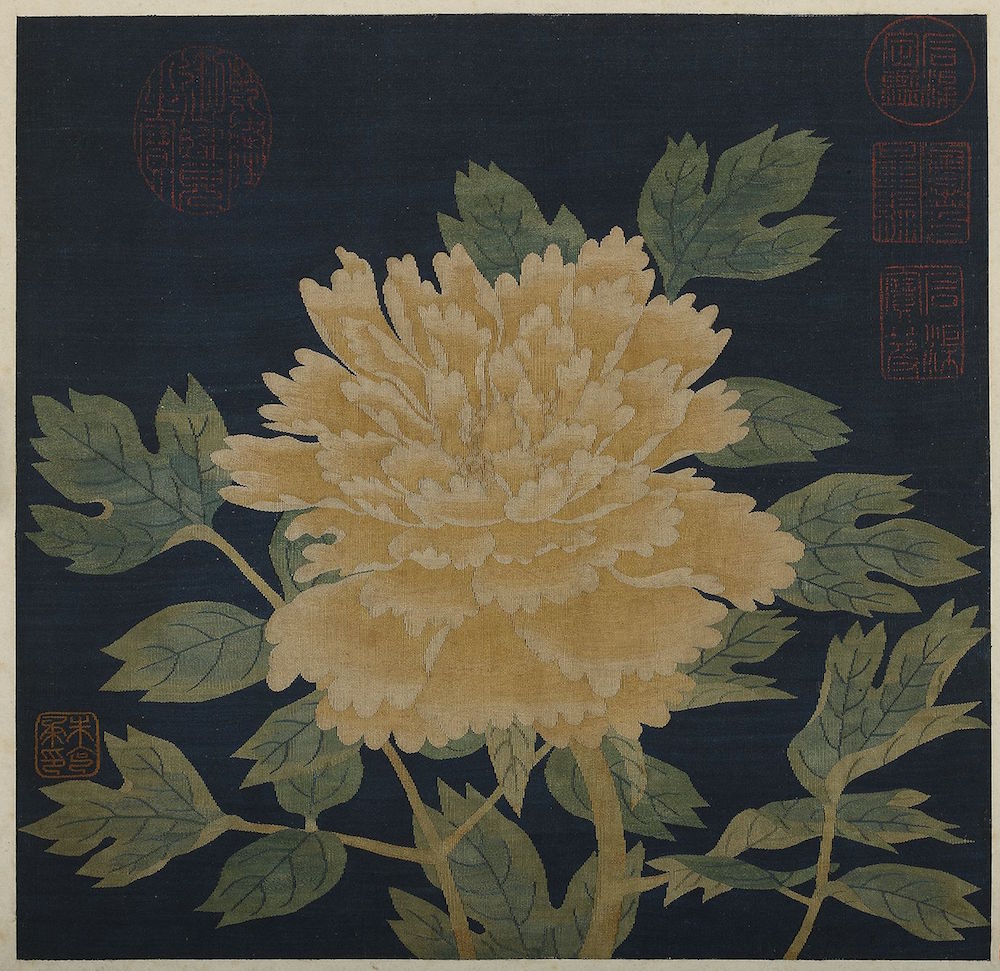
Southern Song Dynasty Zhu Kerou Kesi "Peony Picture", Collection of Liaoning Provincial Museum
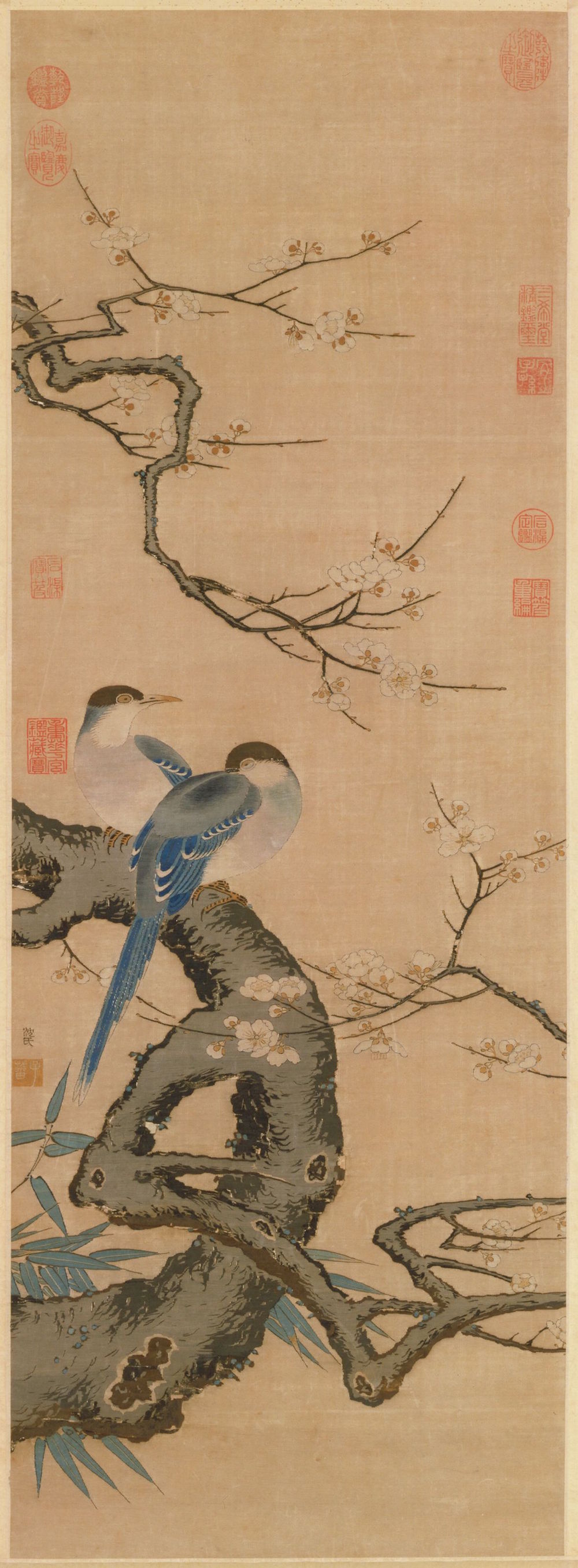
Shen Zifan Kesi "Plum Magpie Picture" in the Southern Song Dynasty, collected by the Palace Museum
The Paper: Since the Pang family donated "Liantang Duckling Picture", has the gloss of this work weakened?
Yu Ying: This work must have faded, the background color is yellowed and deepened due to the aging of fibrin; the red part is a vegetable dye, which is highly sensitive to oxygen and light, so it faded earlier; The green part will also turn yellow, not as bright green as before; the same is true for the azurite part. So it is conceivable that the color of the whole work in the past will be more vivid.
The Paper: What is the constant temperature and humidity standard for displaying this work?
Yu Ying: This work was mounted in Shanghai and has been kept secret in Jiangsu and Zhejiang. The data requirements for temperature and humidity are 60% humidity and 20 degrees Celsius.
The Paper: What is the inheritance of "The Picture of Suckling Duck in Liantang"? At present, what other places need research and evidence for this work?
Yu Ying: In the work, two ducks with mallards float among the weeds, with suckling ducks at their tails, a pair of egrets beside them, and kingfishers, red dragonflies and water striders dotted among them. From the subject matter, it shows wealth and auspiciousness, in pairs. However, judging from the unpaired part in the upper part of the painting, it may be that this work has not been completed or part of it has escaped.
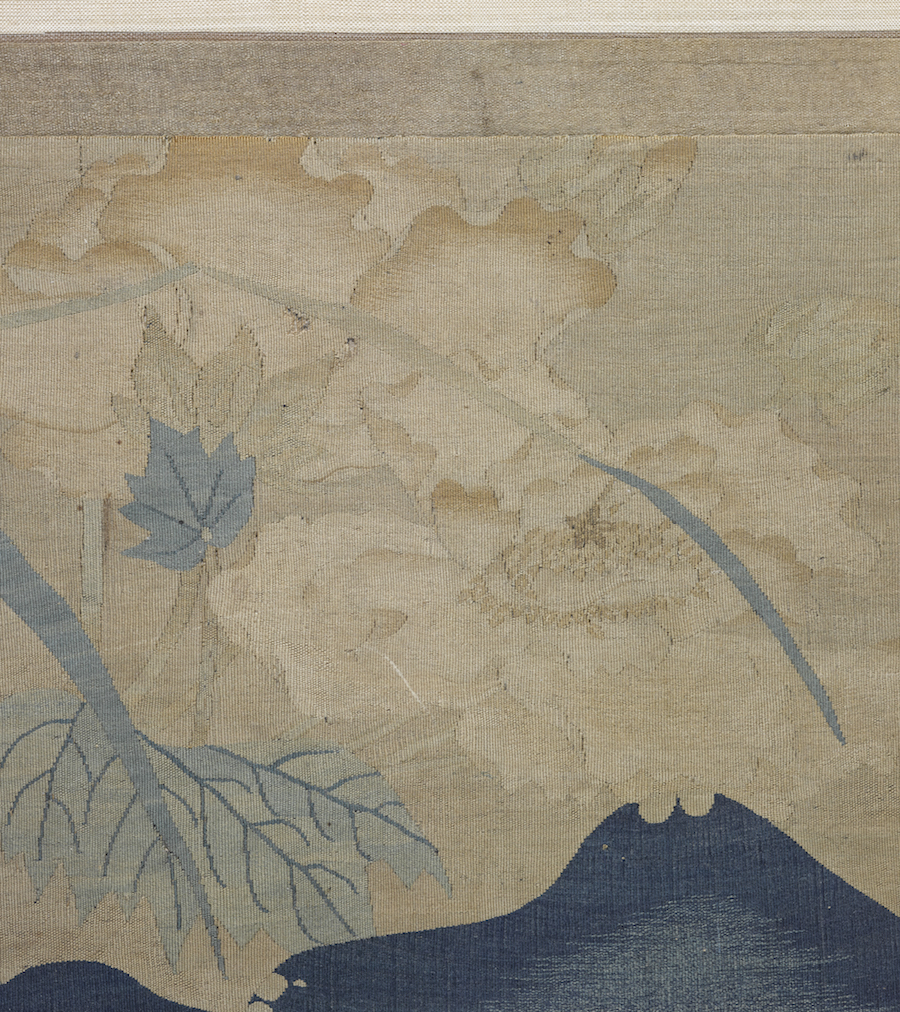
Zhu Kerou Kesi "Duckling Duck in the Lotus Pond" (partial), top of the screen
In the picture, the cyan lake stone is woven with the pattern of "Duckling Duck in Lotus Pond Made by Zhu Gang in the East of the Yangtze River", and "Kerou" Zhu Wenyin. Zhu Gang, courtesy name Kerou, was born in Yunjian (now Songjiang, Shanghai). The year of his birth and death is unknown. He was active in the period of Emperor Gaozong (1127-1162) of the Southern Song Dynasty. He was especially good at Kesi painting, and his Kesi works are hard to distinguish. Among Zhu Kerou's works handed down from generation to generation, this is the only one that left the taboo of Zhu Gang's name. This work was collected by a close friend Pang Yuanji (1864-1949), with the imprints of "Wu Xing Pang's Collection", "Secret Play of Xuzhai", and "Authentic Works Collected by Laichen". Pang Yuanji's "Xu Gaoming Hua Lu" and Zhu Qiqian's "Silk Embroidery Notes". We could not find any records before this, so we believe that Zhu Kerou Kesi's "Liantang Duckling Picture" was once secretly hidden in the Jiangnan area.

Zhu Kerou's Kesi "Duckling in the Lotus Pond" (partial), "Duckling in the Lotus Pond Made by Zhu Gang in Jiangdong"
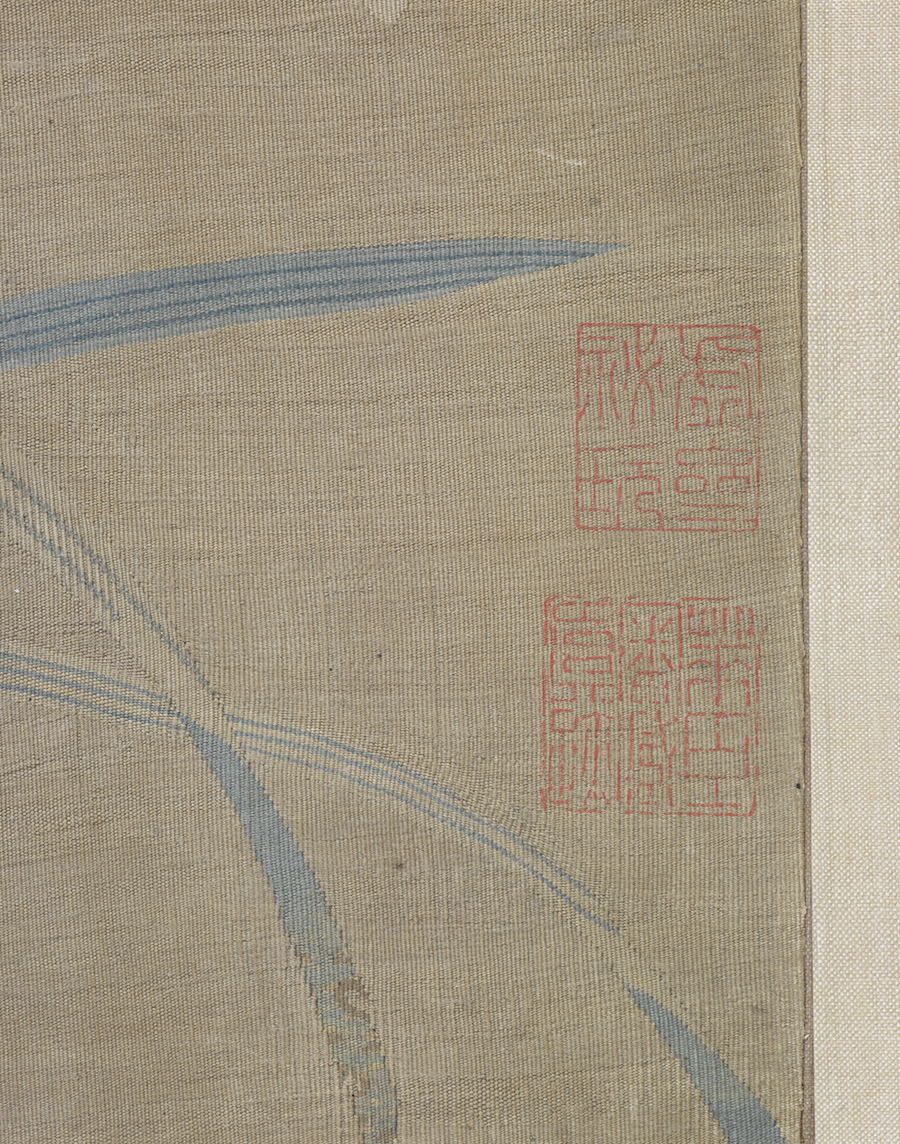
Zhu Kerou's Kesi "Ducklings in Liantang" (partial), engraved with "Secret Plays of Xuzhai", "Authentic Works Collected by Laichen"
Wen Zhengming's great-grandson Wen Congjian recorded Zhu Kerou who he knew, "Zhu Kerou, a man in Yunjian, was popular in the world as a female red in Song Siling's time. The figures, trees, stones, flowers and birds are exquisitely crafted and expensive, and they have been passed down to this day. Especially become a rare purchase...", it can be speculated that Zhu Kerou is a woman. At present, there is no conclusion about Zhu Kerou's gender.
It stands to reason that ancient Kesi skills have a high gold content and were passed down from male to female, including the Kesi artists before the founding of New China were also passed down from generation to generation. In the 1950s and 1960s, with the revival of handicrafts and the strengthening of the concept of equality between men and women, women began to engage in Kesi skills. Now there may be more women engaged in Kesi.
The Paper: What are the main technical characteristics of "The Picture of Ducklings in the Lotus Pond"?
Yu Ying: The Kesi techniques in "The Picture of Ducklings in the Liantang" mainly include "coiled thread" matching long and short Kesi, blending Kesi and Ping Ke, etc. The weft thread density is extremely high, generally 80-120 threads/cm, and locally up to 140 threads/cm. The silk thread in the whole picture is fine and suitable, and the technique is superb. Compared with the other two collections of the Liaoning Provincial Museum, the technique of the flowers and birds in "Liantang Duckling Picture" is more mature, which can be seen from the depiction of flowers and birds, the control of curves, and the mastery of color gradients.

Zhu Kerou's Kesi "Duckling Duck in the Lotus Pond" (partial)
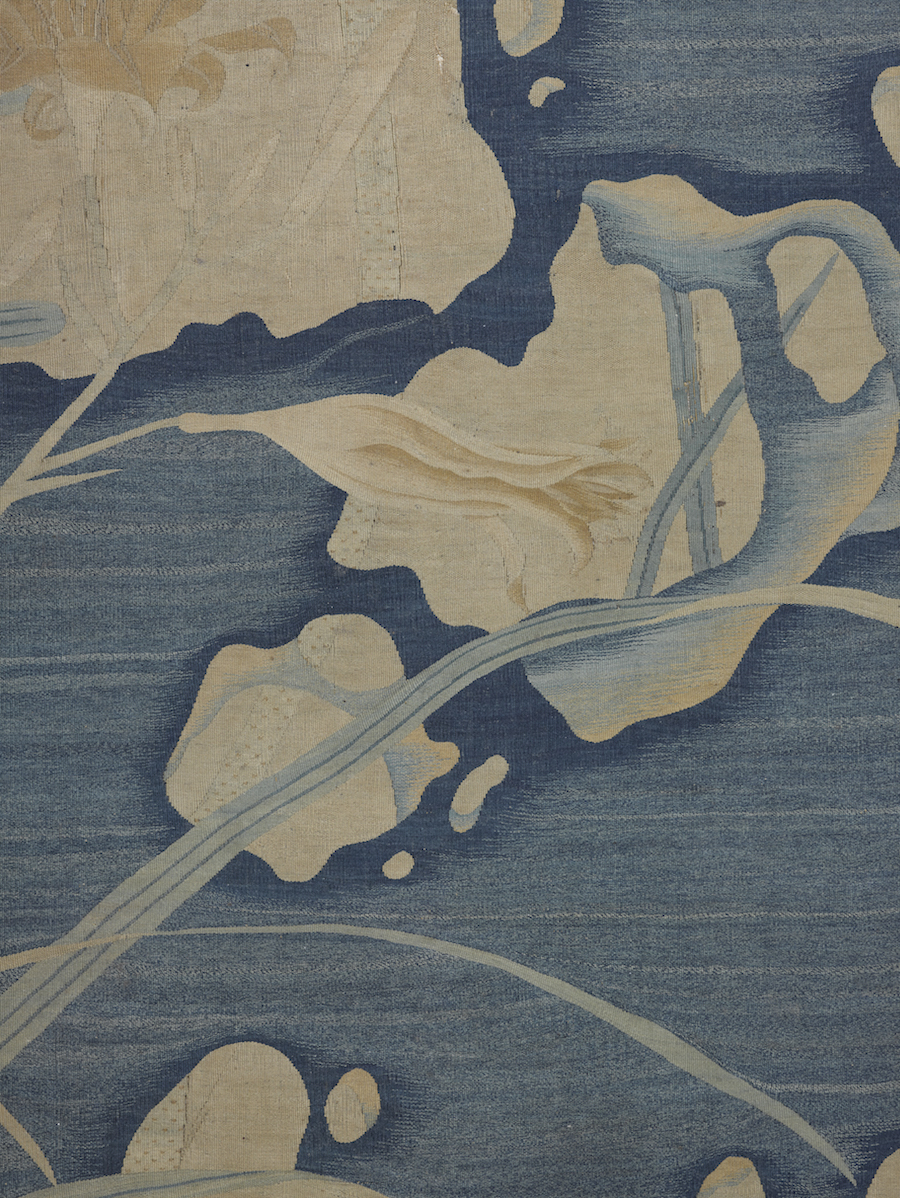
Zhu Kerou's Kesi "Duckling Duck in the Lotus Pond" (partial)
The Paper: What is the relationship between the other two works in the exhibition and "The Picture of Ducklings in the Lotus Pond"? And how to show the influence of Kesi in Southern Song Dynasty on Kesi in Ming and Qing Dynasties?
Yu Ying: The works on display this time are all Kesi works donated by the Pang family, except for Zhu Kerou's "Duckling in the Lotus Pond", and the other two of the six pieces donated by their family. From the donated Kesi, we selected two relatively good pieces of Ming and Qing Kesi, hoping to show the influence of Song Dynasty Kesi paintings on later generations.
The popular theme in the Southern Song Dynasty was the theme of flowers and birds, and the two Ming and Qing works selected this time are also themes of flowers and birds. From the design of the theme to the court courtyard style of the manuscript of Kesi, they all come down in one continuous line. The manuscript here refers to the author having a drawing in his mind before making Kesi, or drawing a manuscript handed down from generation to generation. Especially in the Kesi works during the Ming and Qing Dynasties, the same drawing may be used for several pieces, but some changes will be made in some parts. In comparison, the works of the Southern Song Dynasty are a manifestation of individuality, and there will be fewer reprints and copies.
The Paper: A part of the exhibition also shows the complex kestrel works of contemporary craftsmen.
Yu Ying: This part is a 3-fold magnification of part of the "Liantang Duckling Picture" by the craftsmen of Shanghai Silk Group Corporation. The audience can turn over the exhibition board to see the front and back of the Kesi works, hoping that the audience can get close to the Kesi craft.
From imitating it, understanding it, and finally presenting it, for craftsmen, this process is also a kind of improvement, and the method is the best. This is also the original intention of this exhibition, and I hope everyone will appreciate these fine works. At the same time, we hope that in the process of revitalizing cultural relics, inheritors of intangible cultural heritage can learn better, and that the field of Kesi can succeed and flourish.
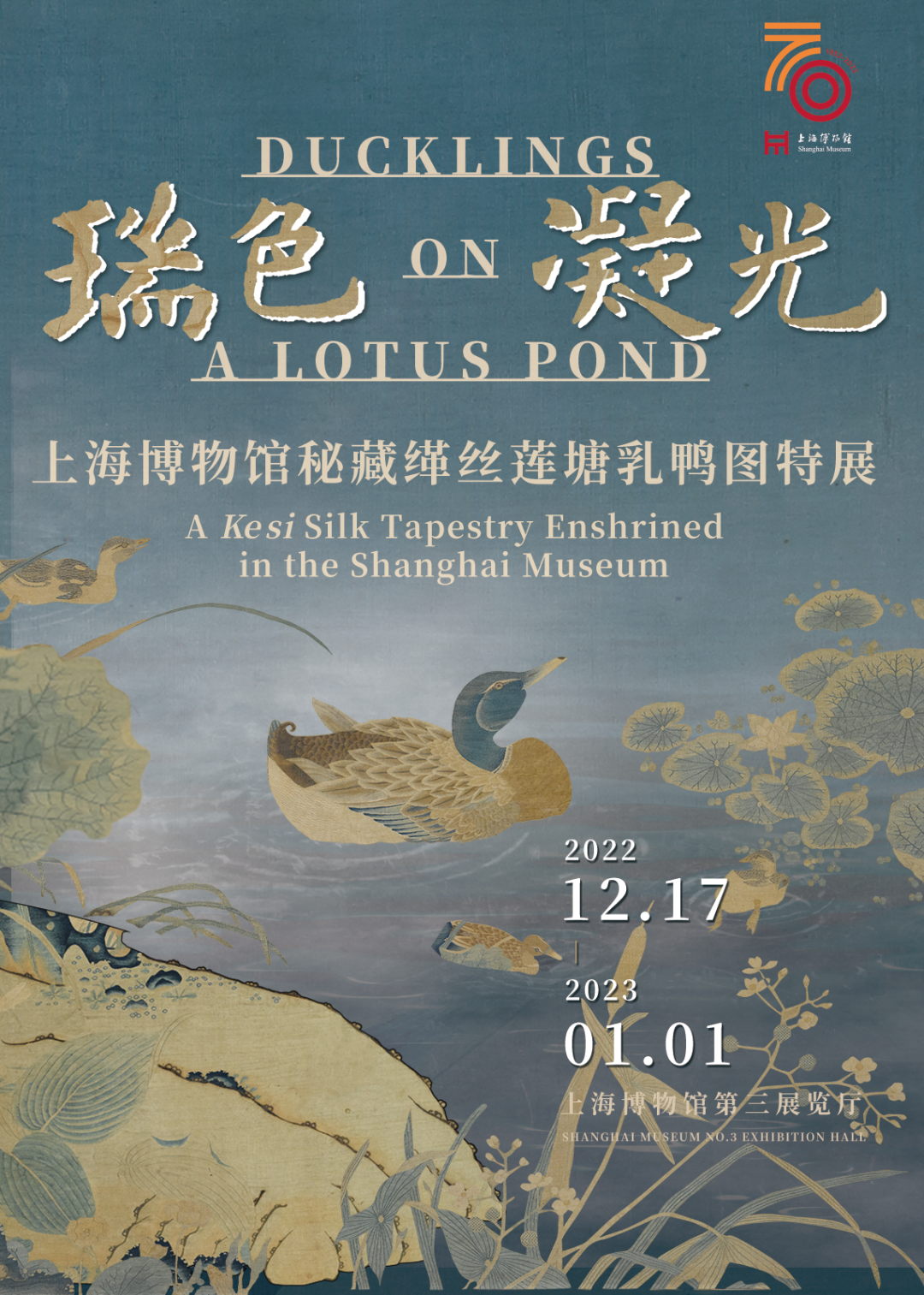
exhibition poster
The exhibition will last until January 1, 2023.
